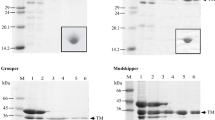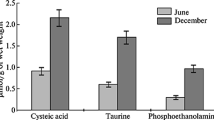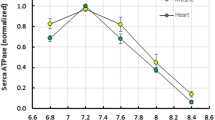Summary
Studies have been carried out on the Mg2+ Ca2+-myofibrillar ATPase from the muscles of fish adapted to different environmental temperatures. The thermal stability of the ATPase is strongly correlated with mean habitat temperature. Activities of Antarctic fish ATPases are significantly higher at low temperatures than those of temperate and tropical water species. The effects of ionic strength on ATPase activity have also been studied. The Gibbs free energy of activation (ΔG #) was found to increase and enzyme activity decrease with increasing ionic strength within the physiological temperature range of each species. Significantly lower values of ΔG #, of around 1 Kcal/mole, are obtained for the ATPase of cold-adapted compared to tropical fish. Enthalpic and entropic activation energies were also reduced in the cold adapted ATPases. It is postulated that the reduction of the enthalpic activation term in the cold adapted enzyme confers the advantage of reducing the temperature sensitivity of the rate limiting step thus partly compensating for the low heat content of the cellular environment. Possible molecular mechanisms of temperature compensation in fish myofibrillar ATPase are discussed.
Similar content being viewed by others
References
Barouch, W.W., Moos, C.: Effect of temperature on actin activation of heavy meromyosin adenosine triphosphatawe. Biochim. Biophys. Acta.234, 183–189 (1971)
Bendall, J.R.: The myofibrillar ATPase of various animals in relation to ionic strength and temperature. In: Biochemistry of muscular contraction (ed. J. Gergely), pp. 87–93. Boston, Mass.: Little Brown & Co. 1964
Bendall, J.R.: Muscles, molecules and movement, pp. 51 et seq. London: Heinemann 1969
Carvalho, C.A.M., Santos, M.S.V.: Effect of heat treatment on the ATPase activity of various sarcoplasmic reticulum preparations. Experientia32, 428–429 (1976)
Fuchs, F., Hartshorne, D.J., Barns, E.M.: ATPase activity and superprecipitation of skeletal muscle actomyosin of frog and rabbit: effect of temperature on calcium sensitivity. Comp. Biochem. Physiol.51B, 165–170 (1975)
Godfrey, J.E., Harrington, W.F.: Self-association in the myosin system at high ionic strength, I. Sensitivity of the interaction to pH and ionic environment. Biochemistry9, 886–893 (1970)
Gornall, A.G., Bardawill, C.S., David, M.M.: Determination of serum proteins by means of the biuret reaction. J. biol. Chem.177, 751–766 (1949)
Hartshorne, D.J., Barns, E.M., Parker, L., Fuchs, F.: The effect of temperature on actomyosin. Biochim. Biophys. Acta.267, 196–202 (1972)
Hazel, J.R., Prosser, C.L.: Molecular mechanisms of temperature compensation in poikilotherms. Physiol. Rev.54, 620–670 (1974)
Hill, T.I., Eisenberg, E.: Reaction free energy surfaces in myosin-actin-ATP systems. Biochemistry15, 1629–1635 (1976)
Hochachka, P.W., Somero, G.N.: Strategies of biochemical adaptation. Philadelphia: Saunders 1973
Johnston, I.A., Davison, W., Goldspink, G.: Adaptations in Mg2+-activated myofibrillar ATPase activity induced by temperature acclimation. FEBS Letters50, 293–295 (1975b)
Johnston, I.A., Frearson, N., Goldspink, G.: The effects of environmental temperature on the properties of myofibrillar adenosine triphosphatase from various species of fish. Biochem. J.133, 735–738 (1973)
Johnston, I.A., Goldspink, G.: Thermodynamic activation parameters of fish myofibrillar ATPase enzyme and evolutionary adaptations to temperature. Nature (Lond.)257, 620–622 (1975)
Johnston, I.A., Tota, B.: Myofibrillar ATPase in the various red and white muscles of the tunny (Thunnus thynnus, L.) and the tub gurnard (Trigla lucerna, L.). Comp. Biochem. Physiol.49B, 367–374 (1974)
Johnston, I.A., Walesby, N.J., Davison, W., Goldspink, G.: Temperature adaptation in myosin of antarctic fish. Nature (Lond.)254, 74–75 (1975a)
Kusakina, A.A.: Relation of muscle and cholinesterase thermostabilityin certain fishes to specific environmental temperature conditions. Fed. Proc., Transl.22, T123-T126 (1963)
Lehrer, G.M., Barker, R.: Conformational changes in rabbit muscle adolase. Kinetic studies. Biochemistry9, 1533–1539 (1970)
Low, P.S., Bada, J.L., Somero, G.N.: Temperature adaptation of enzymes: roles of the free energy, the enthalpy and the entropy of activation. Proc. Natl. Acad. Sci. USA70, 430–432 (1973)
Low, P.S., Somero, G.N.: Temperature adaptation of enzymes: a proposed molecular basis for the different catalytic efficiencies of enzymes from ectotherms and endotherms. Comp. Biochem. Physiol.49B, 307–312 (1974)
Lowey, S., Slayter, H.S., Weeds, A.G., Baker, H.: Substructure of the myosin molecule. I. Subfragments of myosin by enzymic degradation. J. Mol. Biol.42, 1–29 (1969)
Lumry, R., Eyring, H.: Conformation changes of protein. J. Phys. Chem.58, 110–120 (1954)
Lumry, R., Rajender, S.: Enthalpy-entropy compensation phenomena in water solutions of proteins and small molecules: a ubiquitous property of water. Biopolymers9, 1125–1227 (1970)
Perry, S.V., Grey, T.C.: A study of the effects of substrate concentration and certain relaxing factors on the magnesium-activated myofibrillar adenosine triphosphatase. Biochem. J.64, 184–192 (1956)
Precht, H., Christophersen, J., Hensel, H., Larcher, W.: Temperature and life. Berlin-Heidelberg-New York: Springer 1973
Rockstein, M., Herron, P.W.: Colorimetric determination of inorganic phosphate in microgram quantities. Anal. Chem.23, 1500–1501 (1951)
Solaro, R.J., Pang, D.C., Briggs, F.N.: The purification of cardiac myofibrils with triton X-100. Biochim. Biophys. Acta245, 259–262 (1971)
Syrovy, I., Gaspar-Godfroid, A., Hamoir, G.: Comparative study of the myosins from red and white muscles of the carp. Archs. int. Physiol. Biochem.78, 919–934 (1970)
Trentham, D.R., Eccleston, J.F., Bagshaw, C.R.: Kinetic analysis of ATPase mechanisms. Quart. Rev. Biophys.9, 217–281 (1976)
Ushakov, B.: Thermostability of cells and proteins in poikilotherms. Physiol. Rev.44, 518–560 (1964)
Author information
Authors and Affiliations
Rights and permissions
About this article
Cite this article
Johnston, I.A., Walesby, N.J. Molecular mechanisms of temperature adaptation in fish myofibrillar adenosine triphosphatases. J Comp Physiol B 119, 195–206 (1977). https://doi.org/10.1007/BF00686565
Received:
Issue Date:
DOI: https://doi.org/10.1007/BF00686565




